Key highlights
- Understand how affiliate marketing for beginners works and why it’s a legitimate, low-cost way to earn passive income online.
- Learn the exact steps to start affiliate marketing from choosing a niche to joining programs and creating content.
- Explore essential tools like Bluehost eCommerce Premium that simplify setup, email marketing, SEO and link management.
- Discover which affiliate marketing models and channels fit your style, including blogs, YouTube, email and social media.
- Uncover future trends like AI, voice search and mobile-first content that are shaping affiliate success in 2025.
- Key resources for affiliate marketers include affiliate networks such as Amazon Associates and educational content from sites like Shopify and ZINFI.
Affiliate marketing for beginners has become one of the most popular ways to earn passive income online. In 2025, the industry is a multibillion-dollar sector that presents genuine opportunities for creators, bloggers and entrepreneurs. This growth highlights the increasing potential for affiliates to generate substantial income.
Today, various ecommerce brands rely on affiliates to promote products and boost sales. Most affiliate programs are free to join. You don’t need to build a product or manage customer service.
This guide is designed for beginners. You will learn how to find top affiliate programs, add affiliate links and create valuable content that drives clicks and commissions. Whether you’re launching a blog, sharing tips on YouTube or posting on social media, we will help you get off to a strong start.
Let’s delve into how affiliate marketing works and how to transform your content into a source of passive income by 2025.
What is affiliate marketing?
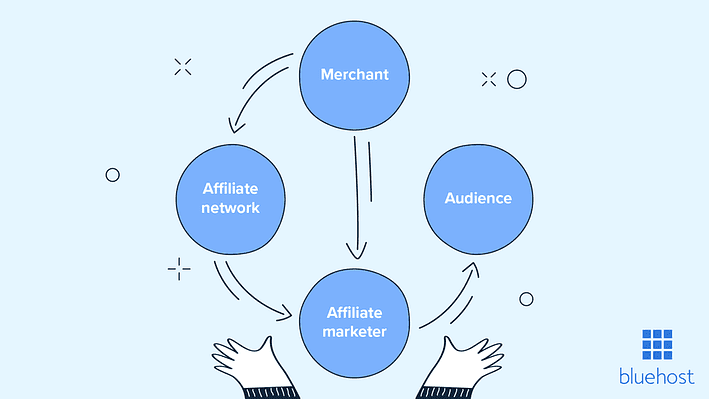
Affiliate marketing is a simple way to earn money online by promoting other people’s products or services. You get a special affiliate link and when someone clicks on it and makes a purchase, you earn a commission. It’s a popular passive income method because you don’t need to create your own products or handle customer service, just recommend what you genuinely trust. Successful affiliate marketers demonstrate unique expertise to create valuable content, which helps build trust and drive conversions.
In this performance-based business model, your income depends on three main factors: the commission rate, how often you make sales and how much traffic you can drive to your content. Many trusted companies like Bluehost, Amazon Associates and Shopify offer beginner-friendly affiliate programs that are free to join and easy to manage through their affiliate dashboards. Analytics tools such as Google Analytics help track traffic, clicks and conversions to understand performance in affiliate marketing.
Affiliate marketing works for both digital and physical products, including software, courses and subscription services. For example, high-ticket affiliate programs may pay larger commissions per sale, while smaller items sell more frequently, both can be profitable with the right strategy. High-ticket affiliate programs offer bigger commissions per sale but sell less frequently than everyday products, making them a strategic choice for affiliates aiming for higher payouts.
In 2025, affiliate marketing remains one of the most effective ways to build an online business, grow your income stream and promote brands you believe in, all while creating valuable content that builds trust and long-term success.
According to Statista, the affiliate marketing industry is projected to cross 12 billion globally, which means there’s never been a better time to get started.
Join our Bluehost Affiliate Program today and watch our Getting Started with Affiliates video to learn step-by-step how to begin your journey.
Why should you start affiliate marketing for beginners in 2025?
Affiliate marketing for beginners is one of the easiest and most profitable ways to earn passive income online. With low startup costs, high commission potential and growing online demand, it’s the perfect time to start your affiliate marketing journey and build a long-term online business.
Here are 6 strong reasons to start affiliate marketing in 2025:
- Easy to start
- Passive income potential
- Rapid growth of online shopping
- Wide variety of affiliate programs
- Performance-based earnings
- Access to modern AI and marketing tools
Let’s discuss each of these in detail and understand why affiliate marketing for beginners continues to be one of the best online income opportunities in 2025.
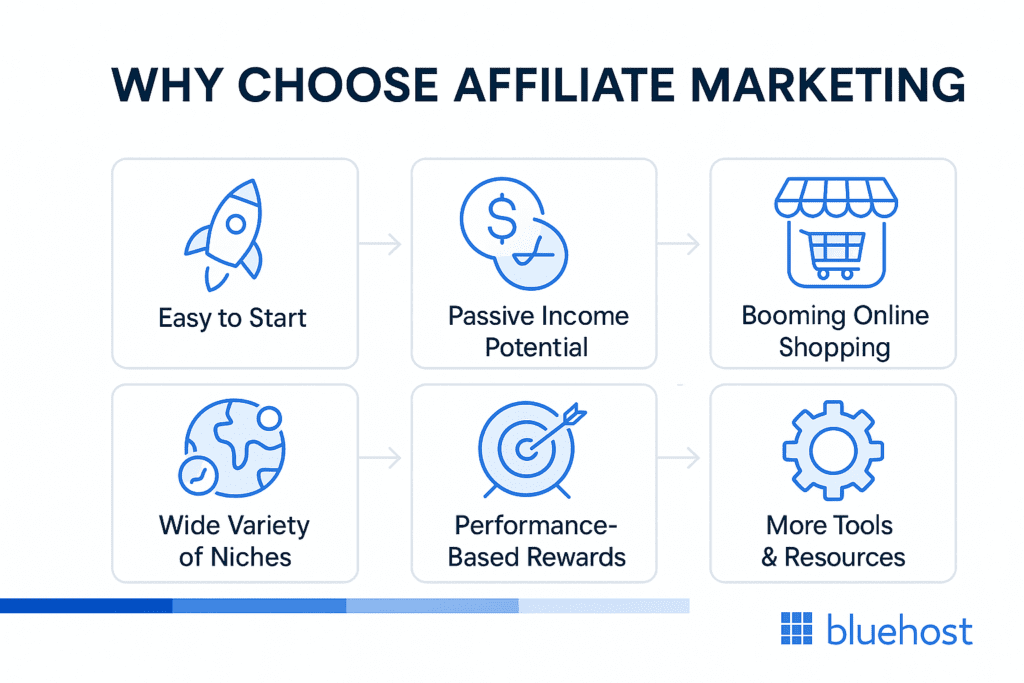
1. Easy to start
Affiliate marketing is one of the simplest ways to begin making money online. You don’t need to worry about creating your own products, handling customer service or managing inventory. All you must do is promote products from other companies and you earn a commission for each sale made through your referral link. This makes it a low-risk business model with minimal upfront investment.
Also read: Top Affiliate Marketing Programs to Boost Your Earnings
2. Passive income
Once you’ve set up your affiliate links, you can earn money even when you’re not actively working. For example, if your links are embedded in blog posts, videos or social media content, they can continue generating commissions over time. This creates a great opportunity to build passive income, where your initial efforts continue to pay off in the long run. Using URL shorteners can improve user experience when sharing affiliate links.
3. Growing online shopping
The shift to online shopping has only accelerated in recent years, especially after the pandemic and it shows no signs of slowing down. As more people shop online, there are more opportunities for affiliates to recommend products and earn commissions. As online shopping continues to grow, more products will become available for affiliate marketers to promote, making it an exciting time to dive into affiliate marketing.
4. Variety of options
Affiliate marketing offers endless options, with affiliate programs available across a wide range of industries. No matter your niche tech, health, fashion, beauty or finance, there’s an affiliate program that fits your interests and audience. This variety makes it easier for you to choose products you’re passionate about and it allows you to cater to specific audiences effectively. Finding brands that align with your personal values increases authenticity and trust with your audience.
5. Performance based
Affiliate marketing is based on performance, meaning your earnings depend on the results you generate. The harder you work to promote products and optimize your strategies, the more money you can earn. It’s a reward system in which your effort directly impacts your income, giving you control over your earning potential.
6. More tools to help
There are many tools available to affiliate marketers now for tracking performance, optimizing campaigns and improving strategies. From advanced analytics to automated marketing platforms, these tools can help you maximize your earnings by offering insights into what works and what doesn’t. The growing range of resources makes affiliate marketing more accessible and efficient than ever before. Affiliate link management tools like ThirstyAffiliates and Pretty Links help organize and cloak affiliate links, enhancing their presentation.
To start and learn affiliate marketing for beginners, you can watch our Masterclass on “Getting Started as a WordPress Affiliate Marketer,” a step-by-step guide to help you choose the right niche, join our Bluehost affiliate programs and start earning online with confidence.
How does affiliate marketing work?
Affiliate marketing for beginners is a simple and trusted way to earn passive income online by promoting products from companies like Bluehost, Amazon or WP Engine. You share unique affiliate links and when someone buys through them, you earn a commission, no product creation, support or inventory needed.
This performance-based model connects three key roles: merchant, affiliate and consume, to create a win-win system where everyone benefits. It’s the foundation of how successful affiliates generate traffic, build trust and make real sales online.
Step-by-step breakdown of affiliate marketing:
- Promote a product or service: Join an affiliate network like Amazon’s Affiliate Marketing Program or Bluehost Affiliate Program, then promote products through your blog, website or social media.
- User clicks your affiliate link: Each affiliate gets a trackable referral link. When someone clicks it, cookies record their activity and link it to your account.
- User makes a purchase: The visitor buys or subscribes through your link for example, web hosting, digital tools or online courses.
- Affiliate network records the sale: The action is tracked in your affiliate dashboard. Some programs verify sales instantly, while others confirm after refund periods.
- Merchant confirms the sale: Once validated, the program marks it as a completed referral, ensuring accuracy and preventing fraud.
- You receive your commission: You earn a set amount or percentage, often paid monthly via PayPal or bank transfer. High-performing affiliates earn recurring commissions from ongoing subscriptions.
For example: You review a web hosting service like Bluehost on your blog. A reader clicks your affiliate link, signs up and after the verification period, you earn $65 in commission.
Affiliate marketing continues to grow in high-demand industries, offering tens of thousands of affiliates a reliable income source. With the right keyword research, valuable information and consistent effort, you can successfully promote trusted brands, attract new customers and build a profitable online marketing business that scales with your skill set and audience size. Effective affiliate marketing often requires knowledge of SEO and audience engagement strategies.
That’s a basic breakdown of how affiliate marketing works, but what kind of money can you realistically expect to make?
How much do affiliate marketers actually earn?
Affiliate marketing can be highly profitable, but how much you earn depends on your experience, niche, platform and traffic strategy.
In 2025, the average full-time affiliate marketer earns over $96,000 per year. This figure represents remote professionals who generate affiliate income through blogs, YouTube channels, email funnels and social media platforms. Additionally, 12% of affiliate marketers earned more than $100,000 annually, indicating the real earning potential within this industry. Amazon’s affiliate program commonly offers commissions ranging from 1% to 10% depending on the product category, with a cookie period of 24 hours.
For beginners, earnings start modestly. However, data shows that affiliate income grows sharply with experience:
- Affiliates with 3+ years in the industry earn 9.45 times more than beginners.
- Even affiliates with just 3–5 years of experience earn 4.46 times more than newcomers.
- Marketers with 10+ years in the field earn 6.31 times more than the overall average.
This income potential makes affiliate marketing one of the most scalable and flexible business models in the digital marketing space. You choose your niche, create high-quality content and grow your affiliate marketing business at your own pace. Consistency in posting valuable content helps in building audience engagement and trust over time.
If you’re starting out, remember: consistent effort leads to long-term growth and real, passive income. Next, let’s explore the different types of affiliate marketing businesses you can build based on your strengths and goals.
What are the different types of affiliate marketing businesses?
Affiliate marketing can be categorized into three main types based on how closely the average affiliate marketer is connected to the product they’re promoting:
- Unattached affiliate marketing: In this case, the affiliate has little to no expertise or connection to the product they’re advertising. For example, a fashion blog running ads for gym equipment without having any experience or authority in fitness.
- Related affiliate marketing: This type involves promoting products that are closely tied to the affiliate’s area of expertise or niche. For example, if you’ve worked in a cafe, you could use your knowledge to recommend coffee brewing machines to others.
- Involved affiliate marketing: This type is more hands-on and requires the affiliate to have direct experience with the product. For example, instead of just recommending coffee machines because of your cafe background, you actually test and review each one to offer detailed, personal recommendations. This approach tends to be more persuasive and trusted by your audience. Product reviews are a popular format for promoting affiliate products as they build trust and provide valuable information to the audience.
Now that you know the types of affiliate models, let’s look at the top channels you can use to grow your affiliate income in 2025.
Which affiliate marketing channels can you use in 2025?
Affiliate marketing for beginners offers endless opportunities to earn actual sales through the right platforms. You can start small, build trust and grow your email subscribers by using the best-performing affiliate marketing networks and platforms that make sense for your audience and niche.
Here are 5 top channels for affiliate marketing in 2025:
- Blogging & niche websites
- YouTube channel
- Email marketing
- Social media platforms
- Microsites & landing pages
Let’s discuss these channels in detail and explore how you can use them to start building your online business, find programs, share marketing materials and earn more sales through trusted affiliate networks like the Amazon Affiliate Program and Bluehost Affiliate Program Review.
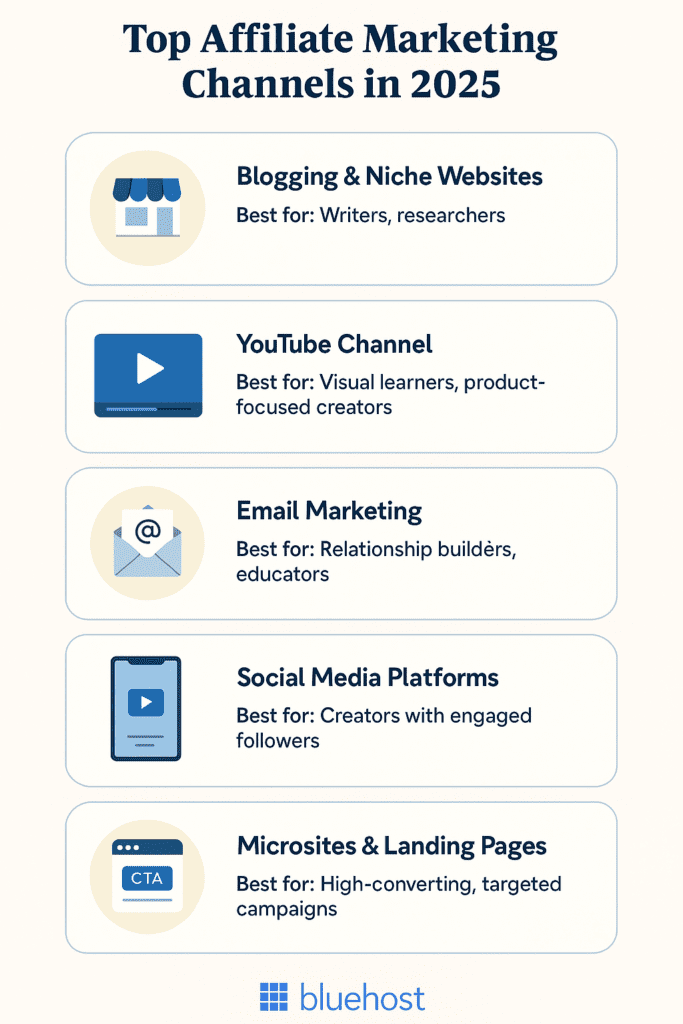
1. Blogging and niche websites
A blog or affiliate marketing website gives you full control over your content and SEO. You can create informational content, tutorials, reviews and rankings that attract organic traffic from search engines. Tutorials are particularly effective for driving affiliate sales, especially for software products.
- Best for: Writers, researchers, long-term growth
- Monetization: Add affiliate links within blog posts, product comparisons and buying guides
Example: A niche site that reviews home office gear with referral links to Amazon or other affiliate partners.
Also read: Affiliate Blogging 101: Crafting High-Value Content that Sells
2. YouTube channel
YouTube is a top choice for affiliate marketers who prefer video. You can create tutorials, unboxings or product comparisons and place affiliate links in your video descriptions.
- Best for: Visual learners, product-focused creators
- Tip: Use strong calls to action and visual demonstrations
Example: A creator reviews podcast mics and links to each one in the description using their affiliate dashboard links.
Also read: YouTube for Small Business: Grow Your Brand with Video
3. Email marketing
Email remains one of the highest-converting channels for affiliate promotions. Build a list, segment it by interest and send value-packed messages that include affiliate offers.
- Best for: Relationship builders, educators, brand-focused creators
- Tools: Use Google Analytics and conversion tracking to measure link clicks and sales
Pro tip: Utilize a branded inbox with Bluehost Professional Email to enhance your sender credibility and prevent your emails from being sent to spam folders.
Example: A digital product creator sends a weekly newsletter with exclusive affiliate deals.
4. Social media platforms
Use platforms like Instagram, TikTok, Twitter and Facebook to share affiliate content. Post reels, stories or live videos to highlight products and direct users to your affiliate marketing website or bio link.
- Best for: Creators with engaged followers
- Caution: Always disclose affiliate partnerships and use approved links
Example: A fashion influencer shares a try-on video and includes links to each item, along with referral links, in the caption or bio.
Also read: Advantages of Social Media Marketing + How to Use It For Your Business
5. Microsites and landing pages
Microsites are focused, single-topic websites designed to rank for specific keywords or promote a single product. These are great for paid traffic and search engine optimization.
- Best for: Targeted campaigns, high-converting funnels
- Pro tip: Combine with PPC ads or influencer partnerships for better ROI
Example: A single-page site comparing AI writing tools with CTA buttons for each affiliate program.
Each channel has its strengths. You can start with one, such as blogging or YouTube and expand as you grow your audience and optimize your affiliate marketing efforts. Ready to dive in? Let’s walk through the step-by-step process of how to start affiliate marketing the right way.
Also read: Common Affiliate Marketing Mistakes and How to Avoid Them
How to start affiliate marketing (Step-by-step)?
If you’ve ever wondered how to start affiliate marketing for beginners and actually make money online, you’re in the right place. Affiliate marketing is one of the fastest-growing online business models and the best part is you don’t need to create your own product. Instead, you recommend products or services people already buy and you earn a commission when someone purchases through your link.
Here are some steps to follow to start building your affiliate marketing for beginners.
Step 1: Understand affiliate marketing
Affiliate marketing is simple:
- You sign up for an affiliate program (like Bluehost, Amazon or ClickBank).
- You get a unique affiliate link.
- You share that link on your blog, YouTube channel, social media or email list.
- When people buy through your link, you get paid.
Example: You write a blog post titled “Best Affordable Hosting for Beginners” and include your Bluehost affiliate link. If someone buys hosting after reading your post, Bluehost pays you a commission.
Step 2: Choose the right niche
This is a key part of affiliate marketing. Don’t try to promote everything at once. Focus on a niche where people buy frequently and trust recommendations.
Popular niches include:
- Tech & software: hosting, AI tools, SEO tools
- Health & fitness: supplements, diet plans
- Finance: credit cards, investments
- Lifestyle: fashion, travel, beauty
For beginners, blogging and online business tools are great niches because very few people realize how much money companies like Bluehost pay affiliates.
Step 3: Pick the best affiliate programs
There are thousands of affiliate programs, but not all are beginner-friendly. Here are some popular affiliate networks and programs to consider:
- Amazon Associates: Physical products (small commission, but high trust).
- ClickBank / Digistore24: Digital products (high payouts).
- ShareASale & CJ Affiliate: Variety of brands and products.
- Bluehost Affiliate Program (Recommended): One of the highest-paying hosting affiliate programs.
Bluehost Affiliate Program Review
Bluehost is trusted by millions of websites and is officially recommended by WordPress. The program is beginner-friendly because:
- You earn $65+ per sale (sometimes even more).
- Every new customer gets free products like a free domain name + SSL certificate.
- Hosting starts at an affordable rate, which makes it easy to promote.
- They often provide a coupon code to make your offer even more attractive.
This combination (free domain + reliable hosting + big payout for you) is why Bluehost is one of the best platforms for affiliate marketing for beginners.
Step 4: Create your affiliate marketing website
If you’re wondering which platform is best for affiliate marketing for beginners, the answer is: your own website. Social media is great, but a website builds long-term authority and traffic.
Here’s how to start an affiliate marketing website for beginners:
- Buy hosting (Bluehost is an easy option because it comes with a free domain).
- Install WordPress in one click.
- Choose a simple theme.
- Write your first affiliate blog post.
Example: A beginner could start a site like TechForStarters.com and publish posts like “Best Hosting for Beginners in 2025” or “Top 5 AI Tools for SEO.” Each post would include affiliate links.
Step 5: Create content that people trust
The truth is people don’t just buy because you tell them to. They buy because your content helps them to make a decision. That’s why your focus should be on research and creating high-quality content.
Content ideas:
- How-to guides: “How to Start a Blog in 2025”
- Product reviews: “Bluehost Affiliate Program Review”
- Comparison posts: “Bluehost vs Hostinger: Which is Better for Beginners?”
- Lists: “Top 10 Affiliate Marketing Websites for Beginners”
The key part is to provide real value. If someone reads your post and thinks, “Wow, this solved my problem,” they are much more likely to click your affiliate link and buy.
Step 6: Get traffic to your website
No matter how great your content is, if nobody sees it, you won’t make sales. Here are some traffic strategies:
- SEO (Search engine optimization): Helps you rank on Google.
- YouTube: Product tutorials, reviews, comparisons.
- Social media: Instagram Reels, TikTok, Facebook groups.
- Email marketing: Build a list of subscribers and send recommendations.
Fact: According to HubSpot, businesses that blog get 55% more website traffic. That’s why affiliate marketing websites for beginners often focus on SEO-driven blogs.
Learn proven SEO for affiliates strategies to rank higher, attract buyers and create content that sells consistently with our expert masterclass.
Step 7: Track and improve
Affiliate marketing isn’t a one-time job. You need to track what’s working.
- Check which posts get the most clicks.
- Find out which affiliate products actually sell.
- Double down on the strategies that bring results.
For example, if you notice that your article “How to Start a Blog with Bluehost” gets more sales than your AI tools review, then you can create more related content around blogging and hosting.
Now let’s see which tool is best to build your affiliate workflow.
Also read: A Beginner’s Guide to Paid Ads for Affiliate Marketing
Why is Bluehost the best affiliate marketing tool for beginners?
At Bluehost, we understand that affiliate marketing for beginners can feel overwhelming. You’re launching a new business, learning how to promote products and trying to figure out which platform is best for affiliate marketing for beginners. That’s exactly why Bluehost is trusted by thousands of new affiliates worldwide.
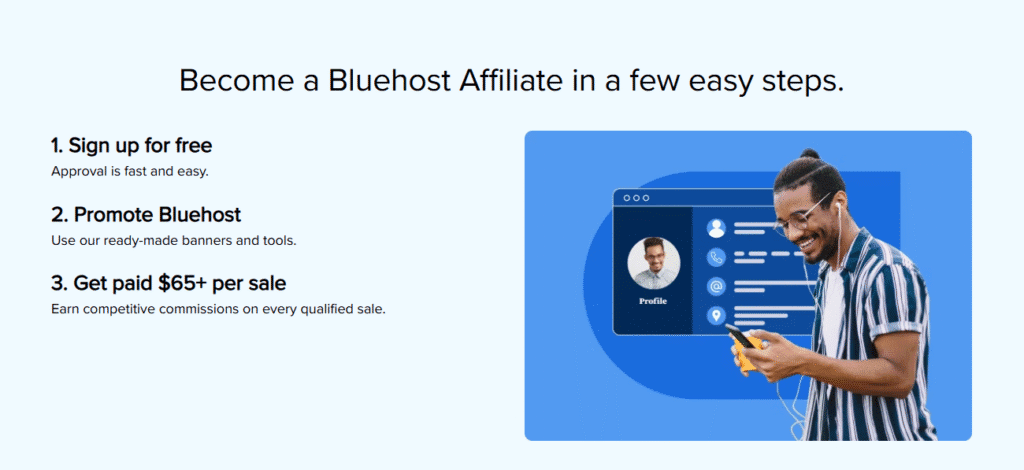
Our platform doesn’t just provide hosting. With our Bluehost Affiliate Program and hosting solution, we give you the complete toolkit to launch, grow and scale your affiliate marketing website with confidence.
Here’s why Bluehost stands out as the best affiliate marketing tool for beginners.
1. A Complete toolkit to get started
Starting an affiliate site doesn’t have to be expensive or confusing. With Bluehost, you get everything in one place:
- Free domain name included with hosting.
- Drag-and-drop builder to design pages quickly.
- Optimized WordPress themes built to increase conversions.
- Free SSL, daily backups and secure hosting.
No steep learning curve. No need to buy multiple extra tools. You can launch a professional affiliate marketing website at a low cost and start focusing on creating content that earns commissions.
Fact: Bluehost Affiliates earn $65+ per qualified sale. That’s one of the highest payouts in the industry for beginners.
2. Capture and convert your audience
One of the most important affiliate marketing tips is to build an email list early. Why? Because email marketing consistently converts better than social media.
With Bluehost, you get:
- Jetpack CRM to manage and organize your leads.
- CreativeMail to automate email campaigns and affiliate promotions.
- Customizable forms to collect new contacts easily.
This means you can send affiliate offers, product reviews and coupon codes directly to your subscribers, helping you generate consistent clicks and sales.
3. SEO and traffic growth made easy
Traffic is the lifeblood of affiliate marketing websites for beginners. Without it, people can’t find your content or click your links. Bluehost makes SEO simple by giving you:
- Yoast SEO integration to optimize your site for search engines.
- Fast, mobile-friendly themes that rank higher in Google.
- Google Analytics integration to track traffic and user behavior.
Instead of worrying about complex technical SEO, you can focus on writing great content like:
- “Bluehost Affiliate Program Review”
- “Best Hosting for Beginners in 2025”
- “How to Start a Blog With Free Domain (Step by Step)”
4. Built-in plugins designed for affiliates
Bluehost works closely with affiliate marketers, so our ecosystem supports the tools you actually need:
- ThirstyAffiliates: Manage and cloak affiliate URLs.
- YITH WooCommerce Affiliates: Build sub-affiliate models if you scale.
- Content tools: Create reviews, tutorials and comparison posts that build trust.
This means you can publish articles that not only rank but also convert readers into buyers.
5. Security and support you can trust
When you’re just starting, tech issues can be scary. With Bluehost, we take care of the technical side so you can focus on affiliate marketing.
- Daily site backups and malware scanning.
- Dedicated WordPress support, 24/7.
- Scalable hosting to grow with your business.
This ensures your affiliate site stays secure and online, no matter how big your audience gets.
Why beginners choose Bluehost Affiliate Program
Here’s what makes the Bluehost Affiliate Program perfect for new marketers:
- High payouts: $65+ per referral.
- 30-day tracking window for referrals.
- Access to banners, links and promo materials in the Affiliate Dashboard.
- Beginner-friendly website setup with hosting + free domain.
- Long-term growth with SEO, email marketing and affiliate tools.
Very few people realize how much value you get with Bluehost. You’re not just signing up for hosting, you’re joining a system built to make affiliate marketing easier for beginners.
For any queries or questions, you can always visit our Bluehost Affiliate Program FAQs page to get detailed answers.
How to maximize affiliate marketing commissions?
To maximize your affiliate marketing for beginners earnings, focus on trust-building content, smart link placement and data-driven strategies. Success comes from consistent optimization, choosing quality affiliate programs and using insights to turn traffic into actual sales across popular affiliate marketing networks. Successful affiliate marketing requires testing and optimizing content and links based on performance analytics.
Here are 6 proven ways to boost your affiliate commissions:
- Focus on high-quality content
- Place links strategically
- Test and improve with data
- Use psychological triggers
- Promote products that convert
- Keep updating and refreshing content
Let’s explore each strategy to build stronger affiliate campaigns, use effective marketing materials, boost sales and grow income with trusted affiliate networks.
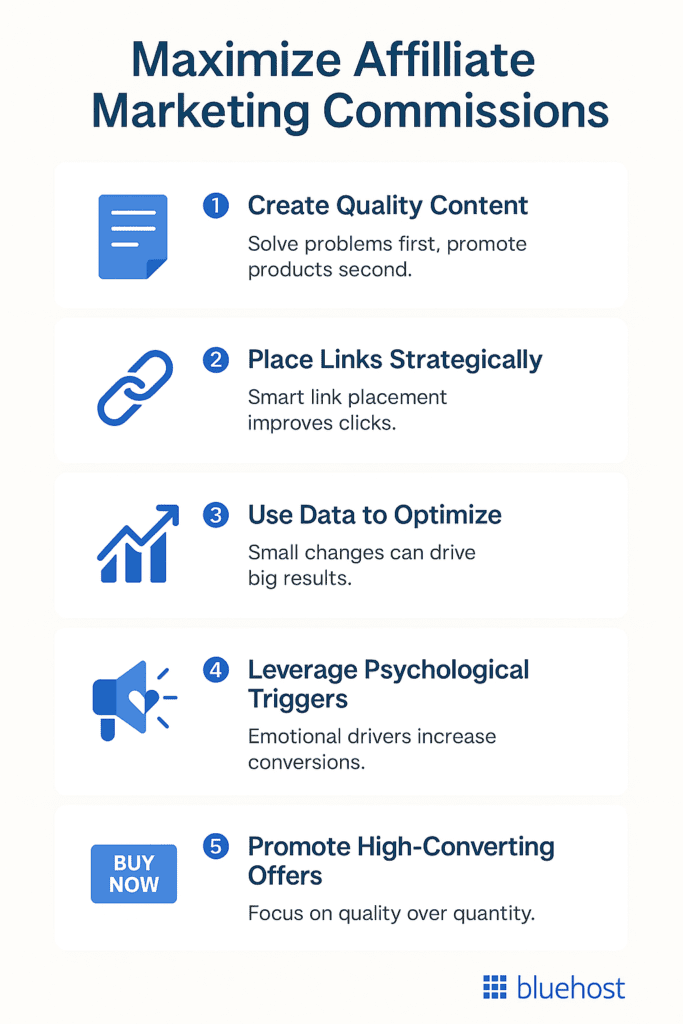
1. Focus on high-quality content
The most effective affiliate marketers create content that’s genuinely helpful. Your goal is to solve a problem, not push a sale.
- Write honest product reviews with pros and cons
- Use real examples and results when possible
- Create how-to guides that naturally feature your affiliate products
People trust content that prioritizes their needs. That trust increases clicks and conversions.
Also read: How to Audit Your Blog and Improve Content Performance (2025 Guide)
2. Place links strategically
Where you place your affiliate links matters. Don’t bury them or overload your content.
Best practices:
- Add links near strong calls-to-action
- Place one link above the fold (visible without scrolling)
- Use buttons or visuals to draw attention
Link naturally within informational content, product comparisons and tutorials.
3. Test and improve with data
Every audience behaves differently. Utilize tools such as Google Analytics, heatmaps and your affiliate dashboard to monitor performance.
Test variations of:
- Headlines and subheadings
- Button colors or placements
- CTAs and phrasing
A small change, like moving a CTA higher, can significantly increase sales.
Also read: How to Write Irresistible Call-to-Actions that Convert
4. Use psychological triggers
Certain emotional triggers can drive higher engagement and clicks.
Examples:
- Scarcity: “Only 3 left in stock!”
- Urgency: “Offer ends tonight”
- Social proof: “Over 10,000 sold this year”
Use them honestly and sparingly. Combined with high-quality content, they help motivate action.
5. Promote products that convert
Don’t waste effort on offers that don’t convert. Choose affiliate programs with:
- Competitive commissions
- Trustworthy landing pages
- Good product-market fit for your audience
Focus your affiliate marketing efforts on offers you’ve personally tested or would recommend. If a product doesn’t perform as expected, replace it with one that does.
6. Keep updating and refreshing content
Your best-performing content deserves attention. Revisit top posts every few months to:
- Add fresh insights or new screenshots
- Replace outdated links
- Improve formatting for mobile readers
Regular updates help your pages stay visible in search results and continue earning commissions. Even though it sounds like it’s easy to earn from affiliate marketing it’s important to follow legal compliance that falls with it.
Watch our Masterclass on Optimizing Your Affiliate Website for Maximum Conversions to learn how to boost clicks, build trust and turn traffic into consistent sales.
Also read: How Fresh Content Improves SEO?
What are legal compliance and affiliate disclosure requirements?
If you want to keep your affiliate marketing business safe and professional, compliance matters. Being upfront about your referral links isn’t just good practice; it’s required by law in many countries, including the United States. Transparency is key; you need to disclose affiliate links to your audience as required by FTC regulations. Affiliate marketing can build trust and credibility when creators disclose affiliations.
Here’s what you need to know.
Disclose every affiliate relationship
The Federal Trade Commission (FTC) requires that you disclose any relationship where you receive a benefit, like a commission, for promoting affiliate products.
You must clearly inform users that you may earn a commission if they click and buy through your links.
Where to disclose
Always add a visible, plain-language disclosure:
- At the top of blog posts or reviews
- In the video description on YouTube
- Within email newsletters or landing pages
- Anywhere you add affiliate links or recommend products
Don’t hide it in your footer or behind another link. Make it clear and unavoidable.
What your disclosure should say
Keep it simple. Here’s an example:
“This post contains affiliate links. If you make a purchase, I may earn a commission at no extra cost to you.”
Avoid vague language. Say what the link is and how it benefits you.
Tips for staying compliant
- Create a full disclosure page on your affiliate marketing website.
- Add automatic disclosure blocks above all affiliate content.
- Use clear labels like “Affiliate Link” or “Sponsored” in buttons or CTAs.
- Keep records of your disclosures and affiliate program terms.
Being honest builds trust. And it shows your audience that affiliate marketing is legit when done the right way and has a great future.
What is the future of affiliate marketing?
The future of affiliate marketing for beginners is bright, AI-driven and filled with new growth opportunities. With evolving affiliate marketing networks, smart tools and mobile-first content, affiliates can now build trust, attract more sales and grow recurring income faster than ever before.
Here are 4 key trends shaping affiliate marketing’s future:
- AI and predictive personalization
- Voice search optimization
- Influencer and creator partnerships
- Mobile-first and social-driven content
Let’s explore these trends to build smarter campaigns, craft impactful marketing materials and grow faster with trusted global affiliate networks.
1. AI and predictive personalization
Artificial intelligence now plays a major role in digital marketing. AI tools can help you:
- Suggest the right affiliate products to promote
- Personalize content for each user
- Optimize landing pages for better conversions
As these tools become more accessible; even beginners can create smarter, data-driven content that converts more effectively.
2. Voice search is growing
People are using voice assistants like Alexa and Google Assistant to find quick answers. That changes how search engines deliver content.
To stay ahead:
- Use conversational keywords in your content
- Answer questions directly with structured formatting
- Add FAQ blocks to your blog posts
This keeps your content visible in voice-based search results.
Also read: Proven Tips That Will Make Your Website Ready for Voice Search
3. Influencer partnerships are expanding
You don’t have to promote everything alone. Many successful affiliates are now partnering with micro-influencers and content creators.
If you have an audience, you can also become an affiliate partner for others. Set up joint campaigns or cross-promote content to expand your reach.
Also read: Influencer Marketing: Boost Your Brand with Strategic Partnerships
4. Mobile-first and Social-driven content
Most users now browse and shop from their phones. That means your affiliate marketing website must be mobile-optimized and fast.
And since social media is where product discovery happens, you’ll see more affiliate marketers using platforms like:
- Instagram stories and reels
- TikTok product demos
- Facebook group promotions
Mobile-friendly, snackable content enhances visibility and facilitates product promotion on the go.
Also read: Mobile Optimization in 2025 – Best Practices
Affiliate marketing in 2025 is more innovative, faster and more connected than ever. If you’re adaptable and committed to delivering value, you’ll find ample opportunities for growth in the years ahead.
Final thoughts
Now that you know how to start your own affiliate marketing program, you’re well on your way to boosting your chances of success. While many dive into affiliate marketing without a clear plan, taking the time to implement the tips from this guide will set you apart.
With a well-thought-out strategy and unwavering determination, you’ll be poised to achieve your goals and thrive in the competitive world of affiliate marketing.
Ready to launch your affiliate website? Begin with Bluehost WordPress hosting to kick off your affiliate marketing business seamlessly.
FAQs
To start affiliate marketing for beginners, choose a niche, join trusted affiliate programs like the Bluehost Affiliate Program or Amazon Associates and create content on a blog, YouTube channel or social media. Add affiliate links, drive traffic through SEO and email marketing and track results in your affiliate dashboard.
Yes, many affiliates earn $100+ daily by promoting affiliate products consistently. Success depends on niche selection, valuable content, SEO and building an audience. Affiliate marketing tips like keyword research, email subscribers and using referral links can turn affiliate sales into passive income once you generate consistent traffic and conversions.
Program and popular affiliate networks like ShareASale or CJ. Bluehost is ideal for affiliate marketing websites for beginners because it offers free products like a domain, high commissions per sale and easy tools for new customers.
Affiliates get paid when referral links generate actual sales. Payments are usually tracked in the affiliate dashboard and sent through methods like PayPal, bank transfer or checks. Bluehost affiliates, for example, earn $65+ per qualified purchase, processed 45–70 days after sales to ensure valid new customers.
Yes, it’s free to start affiliate marketing, you don’t need to create your own product. You can join programs like Amazon Associates or Bluehost Affiliate Program at no cost. However, investing in a website, tools and email marketing makes sense to drive traffic, build trust and increase affiliate sales long-term.
Some of the highest-paying affiliate programs are in software, hosting and finance. Bluehost pays affiliates $65+ per sale, WP Engine offers recurring commissions and premium SaaS brands pay hundreds per referral. While Amazon’s affiliate program and amazon games pays less, high demand and audience size make it profitable for affiliate marketers.
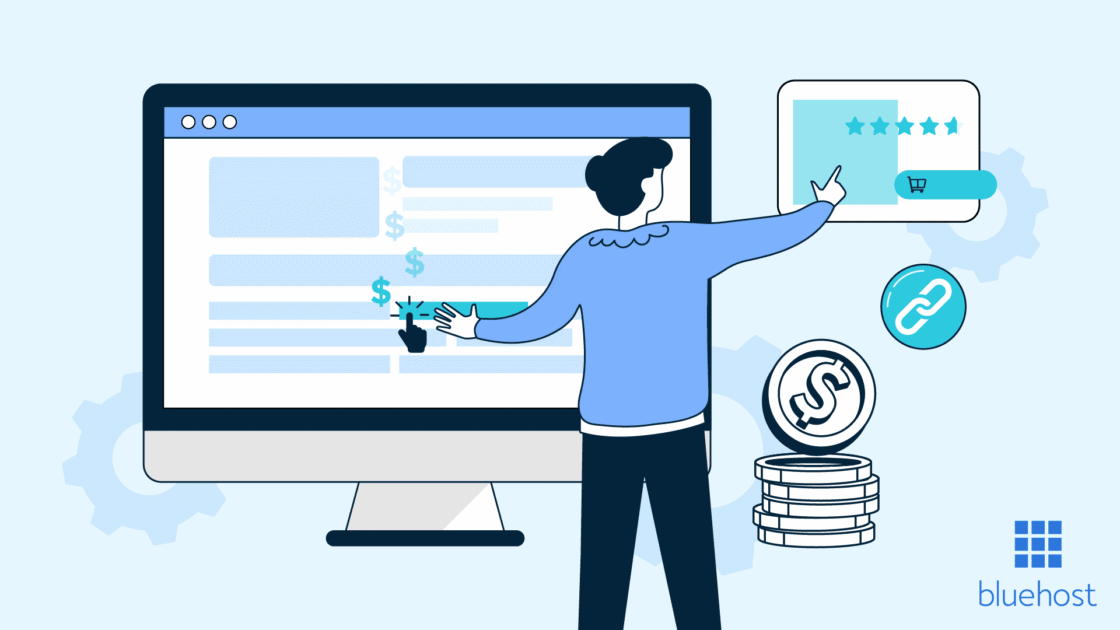

Write A Comment